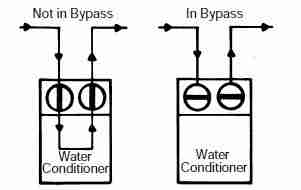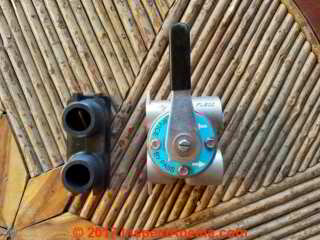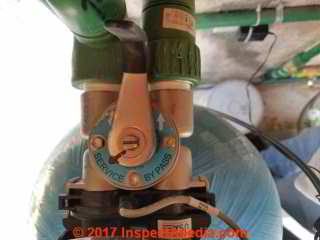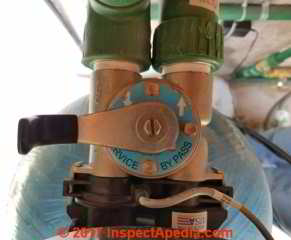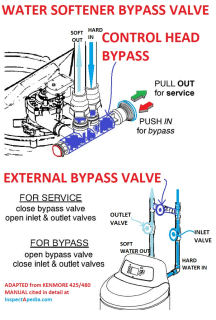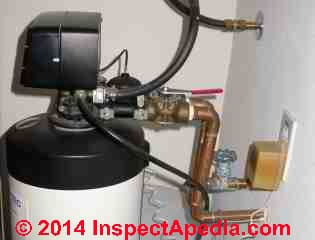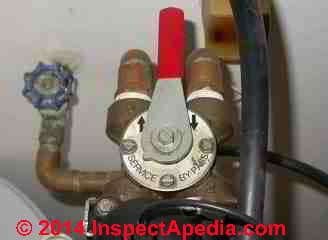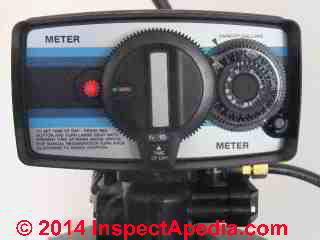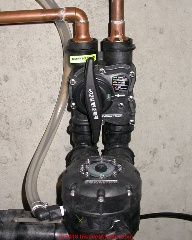 Water Softener Bypass Valve Operation & Repair
Water Softener Bypass Valve Operation & Repair
Put the water conditioner in or out of service
- POST a QUESTION or COMMENT about how to put the water softener or water conditioner into bypass mode.
Water Softener Bypass Valve Operation & Repair Guide:
This article explains how to use & repair the water softener or water conditioner system bypass valve. We explain what is the bypass valve on a water softener & where to find it, and we describe when & how to position the valve to take the water softener/conditioner in or out of service.
We detail how to shut down or turn off a water softener - avoid leaks, wasted water when not in use and we answer the frequent question of Which way do I push or turn the water softener bypass valve? Examples are given of various water softener bypass valve types including Autotrol, Culligan & Kinetico water conditioner bypass valve operation as well as standard plumbing valve arrangements.
InspectAPedia tolerates no conflicts of interest. We have no relationship with advertisers, products, or services discussed at this website.
- Daniel Friedman, Publisher/Editor/Author - See WHO ARE WE?
How to Use & Set the Water Softener Bypass Valve
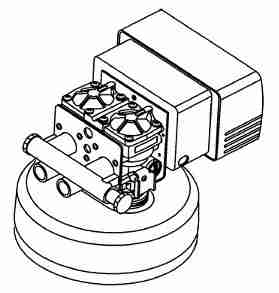
The water softener bypass valve is normally included as part of the control valve assembly on top of the water softener media tank (the smaller tank that handles the actual ion exchange that is the real work of a water softener).
[Click to enlarge any image]
Article Contents
- BYPASS VALVE on WATER SOFTENERS
- TURN WATER SOFTENER ON / OFF / OUT OF SERVICE
- AUTOTROL WATER CONDITIONER BYPASS VALVE
- CULLIGAN PUSH TYPE BYPASS VALVE OPERATION
- FLECK or PENTAIR WATER SOFTENER BYPASS VALVE
- KENMORE (SEARS) WATER SOFTENER BYPASS VALVE
- KINETICO WATER SOFTENER BYPASS VALVE
- LEVER BYPASS VALVE on WATER SOFTENER
- MANUAL WATER SOFTENER BYPASS VALVES
- PROTEC WATER SOFTENER BYPASS VALVE OPERATION
- ROTATING BYPASS VALVE on WATER SOFTENER
- LEAKY WATER SOFTENER BYPASS VALVE REPAIR
- RETURN WATER SOFTENER TO OPERATION
- PIPING ARRANGEMENT & LOCATION of MANUAL BYPASS VALVE
- TURN OFF WATER SOFTENER ELECTRICITY?
How to Place the Water Softener Out of Service or Off
If your water softener has a manual bypass valve (photo at page top and sketch at left), you can temporarily take the water softener "out of operation" - that is, you can put the the valve into bypass position so the water softener is not in the piping loop at all.
When the water softener is on "bypass" water used in the building is not passing through the water softener - the unit will not be treating the building water supply.
Bypassing the water softener and turning it off when the building water supply is not going to be in use removes one more possible source of freeze and or leak damage and it also isolates the water softener equipment from the rest of the building water supply piping.
How to return the water softener to use or operation
To restore the water softener bypass valve back to its prior position (such as restoring the water softener to in-use) simply push on the now protruding knob found on the other end or other "side" of the bypass valve.
How to Fix a Leaky or "Stuck" Water Softener Bypass Valve
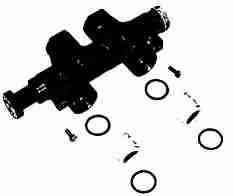 In our experience these manual bypass valves work pretty well on most water softeners, but on occasion we find one that is leaking. Usually the valve was just fine (not leaky) until we disturbed it.
In our experience these manual bypass valves work pretty well on most water softeners, but on occasion we find one that is leaking. Usually the valve was just fine (not leaky) until we disturbed it.
You may need to ask for bypass valve repair assistance from a water conditioner service company, but a few repair details below may help.
Lubricate the water softener bypass valve? The bypass valve on a Culligan™ water softener (and probably most others) connects to the back of the main control valve assembly with two screws.
If the valve is difficult to operate it may need lubrication. Inside are o-rings that permit the valve to operate without leaking.
If these parts appear to need lubrication, use a silicone-based lubricant, not a petroleum-based lubricant which could damage the control.
Leaky Water Softener Bypass Valve? the bypass valve shown in this sketch from a Culligan water softener installation manual includes replaceable o-rings that may be needed if your bypass valve is leaky.
The process of returning a water softener to service in a winterized building is detailed
at RESTORING WATER TREATMENT EQUIPMENT - How do We Return the Water Softener to Operation & Use at the End of Winter?
Autotrol Water Conditioner Bypass Valve Operation
Some water conditioners such as the Autotrol Series 255 use a different (and optional) bypass valve that has two individual knobs that must be turned to switch between in-service and bypass modes - shown at below-left.
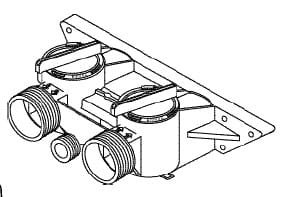
The sketch above shows the optional Autotrol Series 255 Valve / 460i bypass valve. Adapters are available to permit connections to various sizes of copper, NPT (threaded), plastic, and brass water piping.
The sketch above shows the position of the Autotrol bypass valve handles when the water softener is placed in service "Not in Bypass" = "In Service"
and "In Bypass" = "Out of Service"
Watch out: Remember that if an additional external manual bypass valve is "open" (on bypass or in bypass) you will need to also close that valve when the water softener is returned to service ("off bypass").
Culligan Water Softener Bypass Push-Push Valves
 In the Culligan sketch at above left and in our photograph at left the water conditioner bypass valve is that horizontal tube at the left side of the sketch. (Other water softener brand bypass valves are discussed in the article below.)
In the Culligan sketch at above left and in our photograph at left the water conditioner bypass valve is that horizontal tube at the left side of the sketch. (Other water softener brand bypass valves are discussed in the article below.)
Culligan calls this the Cul-Flo-Valve® and suggest that when you are using the valve it should be pushed slowly.
Usually there is a blue (on) or red (off) or a green (on) black (off) knob on this control.
Look for writing and arrows on the bypass valve control knobs.
Some however use black knobs but mark them as ON (in = on) or OFF (in = off).
Pushing in the blue knob on the valve is turning the water conditioner on and allows water to enter and fill the media tank - thus putting the unit in use.
The Culligan bypass valve shown above is operated simply by pushing in on the valve end whose valve stem is visible - or in the "out" position. Our pen is pointing to the valve stem.
When you push horizontally on this bypass valve end (the black knob in our photo) the valve slides - in this case from right to left.
You will see that a corresponding valve or knob on the other end of the bypass valve will move "outwards" at the same time.
Most water softener models using this "push-push" style of bypass valve include colored knobs on each end of the valve as well as text on the knob that indicates whether or not the valve is in "on" position or "bypass" position.
Fleck / Pentair Water Softener Bypass Valve: In Service or On Bypass Positions
These photographs illustrate the in-service and out-of-service or "bypass" positions of a lever type water softener bypass control valve on a Fleck water softener.
The installation of this water softener is also illustrated
at WATER SOFTENER RESIN REPLACEMENT and it is discussed further also
at WATER QUALITY & QUANTITY San Miguel de Allende.
Above, the bypass control valve for a Fleck water softener, before installation. The arrows and the pointer on the bypass valve handle indicate the positions of the control handle to put the water softener into service (in use) or into bypass mode (out of use).
Below: the Fleck brand water softener bypass valve set to SERVICE, meaning that the softener is "in use".
Note that I've coloured the arrow on the bypass valve handle with black magic marker to make clear that it is pointing to the SERVICE mode on the valve body.
Below: we show the Fleck water softener bypass control valve set to BY PASS or "out of service"
Watch out: You'll notice that in order for the water softener bypass control valve handle to rotate successfully past one of the plastic, heat-welded water pipe fittings at the water softener, we had to bend the end of the bypass control valve lever to a 90 degree angle.
If you have to make an adjustment like this be sure to first remove the handle from the valve, then complete your bend. Otherwise you may damage or even ruin the bypass valve's internal parts. Oops!
Sears Kenmore Water Softener Bypass Valve
Using the Sears Kenmore UltraSoft 425/480 water softener as an example, we show two types of bypass valves that take the softener out of or put it into service.
"In service" means that the softener is working to provide soft water.
"Out of servicve" means that water is passing from the water supply source into the building but it is NOT being treated to provide soft water.
To put the softener on bypass
If the bypass valve is integral with the control head (upper sketch) push the integral bypass valve "IN" as shown in our sketch.
OR
If your water softener uses an external bypass valve (the lower plumbing design in our sketch),
CLOSE the inlet and outlet valves and OPEN the bypass valve that in essence is a shunt that bypasses the water softener.
Watch out: put the water softener in bypass mode only when repairs are needed. Leaving the softener in bypass means delivering hard or high-mineral-content water to the building. Over time that is likely to cause scale formation that can clog water heaters, hot water pipes, a tankless coil, or other equipment, leading to a need for costly repairs.
Watch out: don't forget to restore the water softener to service with proper setting of the bypass valve to the SERVICE position when it is ready for use.
Details for this specific bypass valve for this Kenmore water softener are
at KENMORE WATER SOFTENER with Ultra Flow Valve MANUAL, [PDF], (2011
Kinetico Rotating Bypass Valves on Water Conditioners - Water Softeners
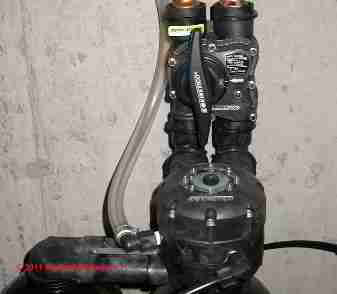
Other water softening equipment may not use the Push-Push type of bypass valve we illustrated above on Culligan Equipment.
The Kinetico water conditioning equipment Mach Series uses a rotating bypass valve shown in our photo at page top and again at left.
[Click to enlarge any image]
Look closely at the photo and you'll see red and green labeling instructions that explain which way this valve is turned to place this water conditioning equipment on "bypass" and which direction the valve is turned to restore it to operation.
See that white arrow to the right of the valve handle (the handle is in a "vertical position)? The tiny green arrow showing in the window pointed-to by the white arrow shows that this unit is in operation.
If the bypass valve is turned until the yellow arrow is showing in the indicator window, this water softener is in "bypass" position.
Pro-Tec Water Softener Lever-Type Bypass Valve Operation
The water softener shown above, installed in a Surprise Arizona home, was placed by Pro-Tec Water Softeners (Pro-TecWater.com). You'll see a similar bypass valve on Fleck and Pentair water softeners too.
This bypass control valve is plainly marked as "Service" and "Bypass" - just turn the red handle to point to "bypass" to take the water conditioner out of service.
Our photo of the water softeners control dial shown below also includes an "In-Service" indication on its control dial. [Click to enlarge any image]
Piping Arrangement & Valve Location for Manual Water Softener Bypass Valves: External Bypass Valves
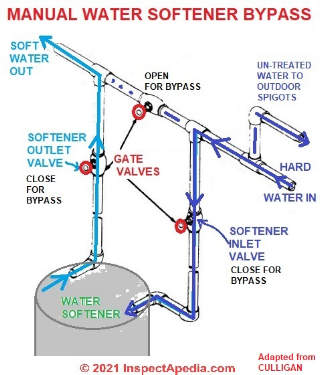
As this sketch from a Culligan water conditioner installation manual shows, a water conditioner, or any water treatment equipment for that matter, can be installed with piping that includes a manual bypass valve (top center in the sketch).
We use this piping arrangement at water filters, for example, not just water conditioners.
The small cost of installing that extra manual bypass valve (and the two service valves shown as outlet valve and inlet valve in Culligan's sketch) means that you can service, repair, or even completely remove the water softener (or other water treatment equipment) when needed, without interrupting water supply to the building.
The Outlet valve and Inlet valve are both closed (turned clockwise) and the bypass valve is opened to achieve this condition.
Watch out: do not leave off the water softener indefinitely.
As we explained
at WATER SOFTENER ADJUSTMENT & CONTROLS, a water softener is not there just for fun.
If your water is hard and you leave the water conditioner off completely, you can expect to face expensive plumbing repairs when the water supply piping, water heater, or tankless coil become clogged with minerals.
[An exception might be if your building is converted from using a private well with hard high-mineral content water to a municipal water supply hookup whose water is low in mineral content. In that case you might no longer need the water conditioner.]
What About Turning off Electricity to the Softener to put it temporarily out of service?
What's the difference between using the water softener bypass valve and simply pulling the (electrical) plug to turn off power to a water conditioner?
Functionally either step is might or might not be the same, depending on the brand and model of your water softener.
Some water softeners do not use any electricity so turning off electrical power is moot: use the bypass valve, Luke.
On a water softener whose control head uses electrical power, when you turn off electrical power (or pull the plug) to a water softener, water is still passing through the equipment.
So, for example, if your water softener is leaky and needs repair, or if you are shutting down the system in order to clean it, you might be better off using the bypass valve to stop water from flowing through the system. use the bypass valve, Luke.
Also see our advice on using the water conditioner bypass valve during winterizing or de-winterizing a water softener when taking steps to protect building plumbing from freezing.
See these details on water softener bypass valve use
at WATER SOFTENER / TREATMENT TURN OFF
and at WATER SOFTENER / TREATMENT TURN-ON.
...
Reader Comments, Questions & Answers About The Article Above
Below you will find questions and answers previously posted on this page at its page bottom reader comment box.
Reader Q&A - also see RECOMMENDED ARTICLES & FAQs
On 2020-09-27 - by (mod) -
Nor do I - we're missing something. Unless you're seeing the brine tank re-plenished after the initial brine draw.
Call product support 1-866-986-3223
Let me know what you're told.
On 2020-09-27 by jamie
pushing through the resin tank and then out the drain hose yes? Don't get why level would be higher then after brine draw.
Silly question....to take water down the drain hose is the well pump needed to come on which in turn would then cause pressure gauge to drop and build back up?
On 2020-09-27 - by (mod) -
Fresh water does not normally enter the softener during brine draw.
Clarifying the "defninition" of a water softener brine draw cycle:
Brine "draw" means
The water softener control is drawing or taking salty water (brine) out of the salt tank (brine tank) and pushing it through the resin tank.
On 2020-09-27 by jamie
Manual not very good- I've searched the internet to see if fresh water comes in during brine draw but found nothing so no answer to why my pressure gauge fluctuates.
In my system the water comes in prior to the brine draw beginning, where other systems will fill in the latter stage . sigh Ive read numerous accounts where the my softener brand is suppose to basically remove most of the water in the brine tank by the end of the cycle, but of course not the case for me.
On 2020-09-27 - by (mod) -
The manual for your softener lacks detail on the cycle but typically
During brine draw brine level drops in the brine tank as brine is sent through the resin tank in the water softener and onwards out the softener drain
A subsequent cycle washes excess brine out of the resin tank
then in a later cycle, often at the end of the process water is returned to the brine tank
On 2020-09-27 by jamie
looked back, sorry, yes it's is suppose to recede, brine draw is approx 60 minutes long and water goes down drain entire time but not lowering the level in tank is odd. I did not see an answer as to whether fresh water is being used during the brine draw which causes pressure gauge to change? I'm so sorry for all these messages I just want some closure. Do you have anymore thoughts/ideas?
On 2020-09-27 - by (mod) -
I replied to that earlier.
On 2020-09-27 by jamie
in my earlier question I said there was about 3/4 inch more in the liquid level of the brine tank after the brine draw finished?
Asked if fresh water comes in during the brine draw as well because the pressure gauge to well pump will drop down to 30 psi and go back up to 50 psi and so forth during brine draw?
On 2020-09-27 - by (mod) -
Have you tried starting over, factory reset, then following the diagnostic steps given in the manual as cited earlier?
Have you actually measured the regen drain volume?
Have you tested the water after regen to see if it's hard or soft?
I'd arm myself with those steps before calling product support 1-866-986-3223 o
On 2020-09-27 by jamie
don't tell me you're leaving me already lol.. ..I pulled the hose from the drain tube while it was in brine mode, water seemed to be coming out fine, not rushing, but then again it's suppose to be a slow trickle so they say, a bit more than a trickle in my opinion though.
The rinse and I believe what is called back wash? rush out the drain hose normally so I don't believe the drain is the problem. What's next :)
On 2020-09-27 - by (mod) -
Jamie
You insist on being rational. <g>
OK that sounds right except that IF the routing is challenging the lift-ability of a softener and IF there is the slightest new deterioration or snafu such as a small air leak somewhere, the softener might not deliver the same volume to the drain.
Keep in mind that no remote diagnosis can be much more than guesswork and a suggestion here and there. Over 50 years of troubleshooting buildings I've found that in virtually every case in which we struggled with some problem and then went to the actual site we always saw something important that we'd missed on remote.
Still the manufacturer's on-phone tech support people have more experience yet with remote diagnosis; it's worth a call.
On 2020-09-27 by jamie
my drain hose set up has been the same for 30 years and I've never had problems before (yes it does extend up and over to sewer line) so that's not it. There are no kinks in that or any of the other tubing, been checked.
I would imagine since this particular softener has worked for 6 years that everything is properly set up?
On 2020-09-27 - by (mod) - instruction manual for older Whirlpool WHES30 / WHES33 Softener
 How maddening
How maddening
I just posted a long comment with suggestions and the darned "comments box" code snarled up and lost it all.
Recapping:
Be sure you've checked for some embarrassing snafus like routing the drain hose too high or an obvious kink or leak in tubing anywhere;
Then Let's go through the diagnostics in the manual, of which there are 2 sets, starting on p. 17 and including a factory reset.
For other readers: if you don't have it you can download the
WHIRLPOOL WHES30 WHES33 INSTALLATION & OPERATION MANUAL [PDF] here.
The drawing excepted below shows a typical installation; note that the drain line is routed just down, not up to the ceiling and over somewhere.
On 2020-09-27 by jamie
I've gone thru the manual numerous times and also did troubleshooting via advice on the internet :( It's a WHES 33 whirlpool . So today I took the venturi apart again and cleaned it for the umpteenth time.
I've replaced all gaskets on the head, gaskets in the venturi, cleaned the brine tube and probably a ton of things I can't remember
Today I actually watched while in brine mode which I assume means the brine is being sucked thru the resin tank and they down the drain hose? When brine was done, prior to going to the rinse mode, I checked the level in the brine tank and it was actually about 1/2 inch higher?
As I said the water is going out the drain hose when softener says its in brine stage. Another question.
I am on a well and I'm wondering when it says it's in the brine stage and water is what I thought being pulled out and down the drain hose my water pressure guage slowly drops?
If softener is not using water during brine stage why is my water pressure being affected.
That's why I earllier asked if during the brine draw out the drain hose is fresh water being used too? Please have patience with me, I hope you will stick with me to the end
On 2020-09-27 - by (mod) -
Jamie:
"when the unit is brining" - not sure which step you're referring to in a softener regen cycle.
"the level in the brine tank doesn't recede" - if you're talking about visible salt, that could be normal or there could be a salt bridge. If you're referring to the liquid or brine level, it should recede by the volume of brine that is in turn determined by the salt dose setting on the softener's control head.
We might make some progress if we start with the brand and model of your water softener.
Armed with that we can pick up the softener's IO manual - if you don't have it - as a free PDF download at WATER SOFTENER MANUALS
In the manual we can see the exact steps that your particular water softener uses. (They're not all identical across all models and brands).
Then we can actually watch the softener as it steps through its cycles and at the "brine draw" cycle we can see what's happening.
We can also test the water hardness before and after a softener regen cycle to determine if it's actually softening the water.
And though it's probably not necessary we could also sample the softener's drainage water during each cycle step;
The initial rinse is not salty
The brine cycle should be salty
The final rinse should be diminishing in saltiness over that cycle's time interval
The output of the softener after all cycles are complete should be low in salt.
On 2020-09-27 by jamie - .when unit is brining there is a slow trickle out the drain hose ... but the brine tank level does not drop
So I'm asking this old question again...when unit is brining there is a slow trickle out the drain hose like it's suppose to.
Yet the level in brine tank does not recede? Don't get it unless the water going out the drain hose is a combination of brine and regular water going out?
In other words, is the water going out the drain during brine mode consist of only water water being sucked out of my tank? I gave up on troubleshooting as I have done everything written to fix this softener lol.
But this hard water is just killing my skin....I'm going to try and tackle this sob again.
On 2020-09-24 by Anonymous
And if you're not handy I don't advise disassembling the valve; unless there are appropriate shutoffs and other means to bypass all of that piping you could find a terrible leak and end up having to turn off your entire water system to wait for a plumber.
A leak is a different problem from a water softener that's not softening the water - though of course if you're stuck in bypass mode the output won't be softened.
On 2020-09-24 by jamie
and how would I take that off to check? turn the water off first I assume lol? (65 yr old woman here :)
On 2020-09-24 by jamie
so would that be why I'm not getting soft water?
On 2020-09-23 - by (mod) -
Jamie
So that sounds like a bad O-ring or gasket in the bypass valve.
On 2020-09-23 by jamie
hard to tell where its leaking........it the type where you push the bypass in and water seems to spurt out around knob that's being pushed in?
On 2020-09-20 - by (mod) -
No it's not normal. Look closely to see exactly where the leak is occurring so the weekend figure out what repair is needed to stop it
On 2020-09-20 by Jamie
When I put my water softener in bypass a mist of water sprays out for a second. Is that normal? Still trying to fix this Whirlpool softener for the last 6 months! Have done everything imaginable no soft water
On 2018-12-29 by mod) - no soft water and it was because of the bad O rings on the Bipass valve
With the exception of a subtle and unlikely condition, the O-rings you replaced should not have caused excessive water usage. After all it's opening cops or running Plumbing fixtures in the building that uses more or less water.
The subtle exception might be that for some models of water softener if the unit is not operating correctly it might have been regenerated more frequently than necessary. That would use additional water.
And of course if I hate water softener is stuck in regeneration mode it could run continuously. But surely you would notice that.
On 2018-12-28 by Dan McDermott
I had no soft water and it was because of the bad O rings on the Bipass valve which were replaced and solved the problem. My question is, when these O rings were defective, would they have caused excessive water usage?
...
Continue reading at WATER SOFTENER ADJUSTMENT & CONTROLS or select a topic from the closely-related articles below, or see the complete ARTICLE INDEX.
Or see WATER SOFTENER BYPASS VALVE FAQs - questions and answers about the bypass valve that were posted originally on this page.
Or see these
Water Softener Diagnosis & Repair Articles
- DIAGNOSE WATER SOFTENER PROBLEMS
- SALT DOSE SETTING, WATER SOFTENER
- WATER SOFTENER ADJUSTMENT & CONTROLS
- WATER SOFTENER CONTROLS & OPERATION
- WATER SOFTENERS & CONDITIONERS - home
- WATER SOFTENER OPERATING CYCLES
- WATER SOFTENER MANUALS
Suggested citation for this web page
WATER SOFTENER BYPASS VALVE at InspectApedia.com - online encyclopedia of building & environmental inspection, testing, diagnosis, repair, & problem prevention advice.
Or see this
INDEX to RELATED ARTICLES: ARTICLE INDEX to WATER TREATMENT SYSTEMS
Or use the SEARCH BOX found below to Ask a Question or Search InspectApedia
Ask a Question or Search InspectApedia
Try the search box just below, or if you prefer, post a question or comment in the Comments box below and we will respond promptly.
Search the InspectApedia website
Note: appearance of your Comment below may be delayed: if your comment contains an image, photograph, web link, or text that looks to the software as if it might be a web link, your posting will appear after it has been approved by a moderator. Apologies for the delay.
Only one image can be added per comment but you can post as many comments, and therefore images, as you like.
You will not receive a notification when a response to your question has been posted.
Please bookmark this page to make it easy for you to check back for our response.
IF above you see "Comment Form is loading comments..." then COMMENT BOX - countable.ca / bawkbox.com IS NOT WORKING.
In any case you are welcome to send an email directly to us at InspectApedia.com at editor@inspectApedia.com
We'll reply to you directly. Please help us help you by noting, in your email, the URL of the InspectApedia page where you wanted to comment.
Citations & References
In addition to any citations in the article above, a full list is available on request.
- [4] North Dakota Standards for Water Softeners, North Dakota General Authority Law, Chapter 62-04-08, Water Softener Units http://www.legis.nd.gov/information/acdata/pdf/62-04-08.pdf. "The objective of this chapter is to provide a standard of quality, capacity, and performance for water softener units. Water softener performance is to be based upon referee tests procedures described in section 62-04-08-09."
- [5] Culligan Mark 10 Water Softener 1994-1998 Installation and Operating Instructions (covering models manufactured after 1995) (1-96) 01881948.pdf available from www.culligan.com
- [6] Water Softeners, CMHC, Canadian Mortgage and Housing Corporation, cmhc-schl.gc.ca/en/co/maho/wawa/wawa_005.cfm - October 2008. Canada Mortgage and Housing Corporation acknowledges the contribution of Health Canada to the development of this document. For further questions regarding water treatment and water quality, contact Health Canada at watereau@hc-sc.gc.ca or call 613-957-2991 or 1-866-225-0709.
- [7] "Commercial Water Softener Installation and Operating Instructions", IBC Filtration & Water Treatment Products (Australia) for commercial, industrial and residential application www.ibcwater.com.au (07) 3219 2233
- [8] "Non electric water softener, Installation and Operating Instructions", IBC Filtration & Water Treatment Products (Australia), op.cit.
- [9] "Water Softener Twin Tank Installation and Operating Instructions", IBC Filtration & Water Treatment Products (Australia), op.cit.
- In addition to citations & references found in this article, see the research citations given at the end of the related articles found at our suggested
CONTINUE READING or RECOMMENDED ARTICLES.
- Carson, Dunlop & Associates Ltd., 120 Carlton Street Suite 407, Toronto ON M5A 4K2. Tel: (416) 964-9415 1-800-268-7070 Email: info@carsondunlop.com. Alan Carson is a past president of ASHI, the American Society of Home Inspectors.
Thanks to Alan Carson and Bob Dunlop, for permission for InspectAPedia to use text excerpts from The HOME REFERENCE BOOK - the Encyclopedia of Homes and to use illustrations from The ILLUSTRATED HOME .
Carson Dunlop Associates provides extensive home inspection education and report writing material. In gratitude we provide links to tsome Carson Dunlop Associates products and services.


